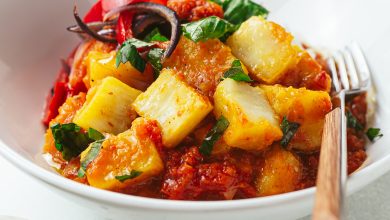Pounded Yam: A Delicious and Traditional Delight
Pounded yam is a beloved dish in many African households, especially in West Africa. It is a staple food known for its smooth, stretchy texture, which makes it the perfect accompaniment to a variety of flavorful soups and stews. This dish is not only delicious but also versatile and easy to make, making it a favorite for many family meals. Whether served with rich vegetable soups, spicy meat stews, or savory fish broths, pounded yam always satisfies and brings people together around the table.
Ingredients:
- Yams (quantity based on desired servings)
Preparation and Cooking Time:
- Prep Time: 10 minutes
- Cook Time: 25 minutes
- Total Time: 35 minutes
- Servings: Varies based on quantity of yams used
Instructions:
-
Peel the Yams:
Start by peeling the yams using a sharp knife. Make sure to remove the skin carefully without wasting too much flesh. While peeling, be sure to discard any discolored or bruised spots that might affect the final taste and texture of the dish. -
Cut and Clean the Yams:
Once the yams are peeled, cut them into large chunks. Immediately rinse them in cold water to prevent discoloration. If you aren’t cooking the yams right away, you can leave them submerged in water to keep them fresh. -
Boil the Yams:
Transfer the yam chunks to a medium-sized pot, making sure there’s enough water to cover the yams completely. Season with a pinch of salt or your preferred seasonings for extra flavor. Place the pot on the stove and bring it to a boil. Allow the yams to cook for 15-20 minutes, or until they are fork-tender and easily break apart. -
Drain and Prepare:
Once the yams are cooked, remove the pot from the heat. Drain the yams in a colander and reserve a bit of the cooking water to help achieve the desired consistency later on. -
Pound the Yams:
Transfer the cooked yams into a food processor. Begin blending them, gradually switching to pulse mode every 20-30 seconds. Continue pulsing and check for smoothness. Add some of the reserved cooking water little by little, as needed, to help achieve the stretchy, smooth texture that pounded yam is known for. -
Form the Pounded Yam:
Once the mixture reaches the perfect consistency (smooth and stretchy), wrap it in parchment paper or cling wrap. Let it sit for a few minutes to set and firm up. -
Serve:
Pounded yam is best served fresh and warm with a soup or stew of your choice. It pairs beautifully with traditional soups like egusi soup, okra soup, or vegetable stew, offering a satisfying and hearty meal.
Allergen Information:
- Allergen Alert: Pounded yam is made from yams, a type of root vegetable, and does not typically contain common allergens like dairy, nuts, or gluten. However, be cautious of any added seasonings or condiments that may contain allergens.
Dietary Preferences:
- Gluten-Free: Pounded yam is naturally gluten-free, making it a great option for those with gluten sensitivities.
- Vegetarian/Vegan-Friendly: This dish is entirely plant-based, making it suitable for both vegetarians and vegans.
Tips & Advice:
- For a smoother texture, feel free to add extra yam cooking water to the mixture until it reaches the desired consistency.
- If you don’t have a food processor, a traditional mortar and pestle can also be used to pound the yam to perfection. This method requires a bit more effort but adds an authentic touch to the dish.
- Pounded yam can be enjoyed with a variety of soups. If you’re looking for a protein-rich option, try pairing it with a rich meat or fish stew. For a lighter, vegetarian meal, pair it with a flavorful vegetable soup.
Conclusion:
Pounded yam is a beloved dish that continues to be enjoyed by many for its simple ingredients and satisfying texture. Whether you’re cooking for a family gathering or simply craving a comforting meal, this recipe offers a timeless, authentic dish that will delight your taste buds. Enjoy it with your favorite soup or stew, and indulge in the rich flavors of West African cuisine. Happy cooking!



